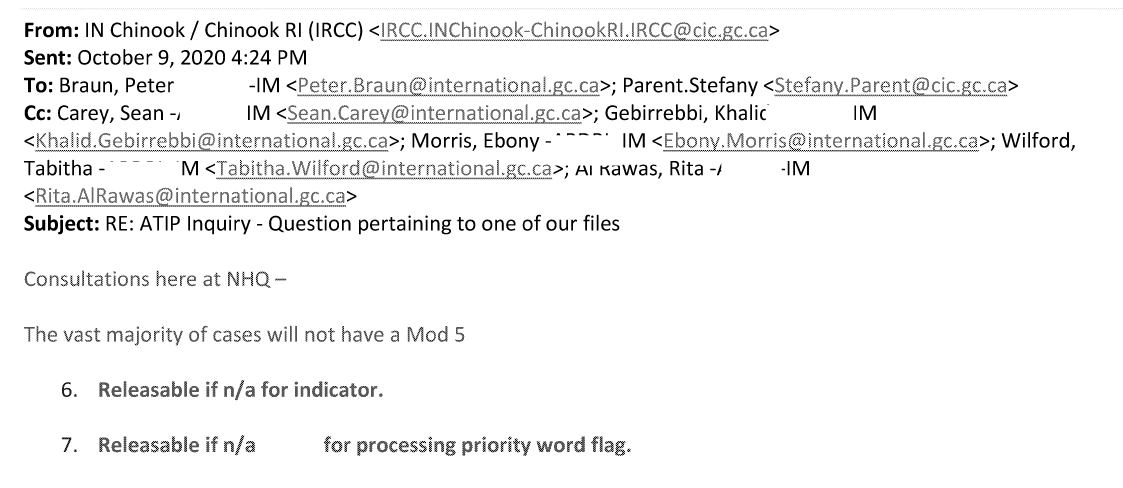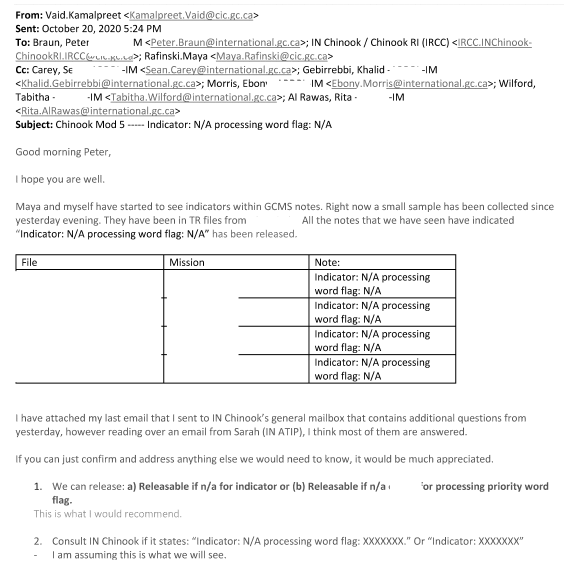One of the more fascinating modules in Chinook is Module 5 – Indicator Management.
Many of you who have received ATIPs for Officer’s GCMS notes or received Rule 9 Reasons from the Federal Court probably see this in your GCMS notes:
But what if this is missing? Folks have yet to see any actual risk indicators processing priority word flags actually show up in ATIP, well here is probably why.
Indicators and Word Flags are Deleted If There is any Indicator/Word Flag
This email exchange from October 2020 between IRCC program officers and ATIP Officers (I won’t get into why I find this problematic in this piece) tells you why.
In this email, guidance is being provided to only use the wording “Indicator: N/A Processing Priority Word Flag: N/A” where there is Indicator or Priority Flag. In other words, the entire section is omitted where there is an Indicator or Priority Word Flag.
Hence the title of this piece.
Question then becomes, how does one actually challenge the lack of disclosure of a risk flag or priority word flag in a decision? For example, in Federal Court. In litigation, reverse engineered explanations will be put forward for why the decision was reasonable – but without the actual indicator/word flag – a large chunk of the decision or perhaps the impetus behind a fettered decision will be missing.
Furthermore, is it one way access. A big defense of the transparency of fairness of Chinook is that the same information is available in GCMS as is in Chinook minus the deletions of working notes (that apparently are not substantive). However, as we have discovered otherwise these notes can be substantive and if Officers are recommended to use standard form wording in refusing cases – we might only be able to rely on things such as risk flags/work indicators – but these are being deleted from GCMS notes and Rule 9 reasons. What if the Department of Justice has access to them (from their client) but we do not. Does that create a procedural fairness issue?
Let’s take a step back and look at what we know so far about Module 5.
Below I will write a running commentary of paras 48-53 of the Daponte Affidavit.
Module 5: Indicator Management (Risk Indicators and Local Word Flags)
38. As described above, Module 5 allows a Chinook user to submit requests to a Chinook administrator to add, renew, or modify “risk indicators” and “local word flags”. “Risk indicators” and “local word flags” are intended to assist Decision-Makers in their review of Applications.
It is to be noted, we still do not know how the system flags/indicates these words to the case. Where it shows up (in what module) to trigger action.
Risk Indicators
39. “Risk indicators” are used to notify Decision-Makers of trends that IRCC has detected, such as a trend that a falsified document was submitted by a certain company in a high number of Applications from different clients or otherwise to highlight a particular factor of concern.
40. “Risk indicators” are also utilized to notify Decision-Makers of potentially low risk Applications; for example, if an international medical conference is being held in Canada, a “risk indicator” may be created to identify entry for such purpose to be of low risk to program integrity.
41. “Risk indicators” may apply to all Applications or to a specific migration office. The inclusion of “risk indicators” within Chinook allows Decision-Makers to view applicable indicators in a centralized manner when determining an Application.
While it is presumed that some of the larger “Risk indicators” are big picture anti-fraud pieces, what about the local office ones? What if something – single, older woman going to attend wedding is an indicator at one visa office, but not at the other? Is local knowledge and Officer’s expertise enough of a justification? Does there need to be oversight?
42. An approved “risk indicator” within Chinook is linked to set criteria. For example, a “risk indicator” may be linked to a client’s declared occupation, such as “petroleum geologist”, or intended employer, such as “Acme Oil”, or a specified combination of criteria, such as “petroleum geologist” for “Acme Oil”.
Again, the specific I understand – the broader flag of “petroleum geologist” seems like it has the possibility of discriminating and I would want it subject to independent oversight.
43. Approved “risk indicators” are presented in the Module 3 Report, along with a recommendation that Decision-Makers perform an activity in assessing an Application, such as a review of proof of credentials or an employment offer letter. The recommendation, however, does not direct Decision-Makers to arrive at any specific conclusion in conducting their assessment, but rather suggests steps to be taken to ascertain information.
I would be interested to seeing what the approval and refusal rates are for cases that are flagged. It would seem to be like a lower Tier flag that could create major challenges. Even though it does not direct a decision, it is hard to see how this does not fetter a discretion with a word such as ‘flag.’
Local Word Flags
44. A “local word flag” is used to assist in triaging an Application in order to ensure priority processing of time-sensitive Applications, such as an Application to attend a wedding or a funeral.
45. A “local word flag” is specific to a particular migration office. For example, the Beijing migration office may obtain approval from the Chinook administrator to include words associated to a wedding, such as “wedding”, “marriage”, or “ceremony”. The matched word found in any Application at the Beijing migration office is then presented in the Module 3 Report.
What separates a risk flag versus a word flag? A local word flag seems to support ‘priority processing’ but how many of these decisions are positive per word versus ultimately, negative?
Indicator Management
46. There is a process to create a “risk indicator” or “local word flag” within Chinook. An IRCC Risk Assessment Officer (“RAO”) or other approved user may submit requests to create such an indicator. A Chinook administrator then reviews requests for approval within Module 5. Each submission must be justified through rationale statements and are subject to modification or denial by the administrator.
This is not surprising. We are aware of this process, although I would mention that from an ATIP on the RAO email account I only saw one Mod5 request (perhaps others redacted) but you can see it below. I also share a copy of what type of flags can be raised.
47. Following the above example, a RAO may find that a number of WP applications have included falsified letters of offer under the name of a specific company, such as “Acme Oil”. The RAO may then submit a request that the company name be included as a “risk indicator” due to concerns of falsified documentation.
This is by all accounts a very positive use of risk indicators. Why not let those who have applied know they have been flagged and perhaps these flags can be accumulated (and some even publicly shared) so we do not have repeat applicants falling for the same trap?
48. Chinook searches for “risk indicators” and “local word flags” in all Applications that are contained in a Module 3 Report. However, such indicators appear in the Module 3 Report only when they may be relevant to a particular Application.
Hence the N/A on several applications. That makes sense.
49. “Risk indicators” and “local word flags” are valid for four months from the date of approval, after which a Chinook administrator may renew or modify the indicator.
What oversight is there of this individual? Their role? Their anti-racism training? Is there a committee or only ONE administrator?
50. As noted above, Decision-Makers or other assigned Chinook users are to “copy and paste” any “risk indicators” or “local word flags” presented in the Module 3 Report into GCMS, where they will be retained. If there are no such indicators, Decision-Makers are to note that these are not applicable to an Application by recording “N/A” in GCMS. I expand on this process immediately below.
Again – why the language of N/A shows up in GCMS.
COMPLETION OF APPLICATION PROCESSING WITHIN CHINOOK
51. Once Decision-Makers finalize decisions for all Applications in a given Module 3 Report, they are to ensure that the decision, reasons, and any “risk indicators” or “local word flags” in the Module 3 Report are recorded in GCMS using the steps described in the paragraphs that follow.
Again, the problem is it is recorded in GCMS but it is disappeared for the Applicant trying to access their own GCMS. Is this fair?
52. Decision-Makers are to click a button labelled “Action List” located within Column A of the Module 3 Report, which organizes data for ease of transfer into GCMS. The created “Action List” presents the decision, reasons for refusal if applicable, and any “risk indicators” or “local word flags” for each Application. If there were no “risk indicators” or “local word flags” associated with a given Application, then Decision-Makers must populate the corresponding GCMS “Notes” field with “N/A” to reflect that no such terms were present in the Module 3 Report.
Which is what we saw with the Rule 9 excerpt I took out. Again, we’ve seen this.
53. Decision-Makers are then required to “copy and paste” the final decision from Chinook into the “Final” field contained in GCMS. Decision-Makers, or assigned Chinook users on their behalf, are also required to “copy and paste” any reasons for decision and the field contents for “risk indicators” and “local word flags” from Chinook into the “Notes” field of GCMS.
So, as counsel, we need to really figure out how to get our hands on these risk indicators because often times – we may be trapped against a flag on our clients, without us even knowing and with the bulk nature by which these flags are being triggered – that will limit the transparency of the final decision. Clients may not be refused directly for these flags, but the presence of the flags, could lead to the finding of a ground for refusal.
In the manual for Chinook, we learn about how easy it is to request a risk indicator in Chinook. The one example that is provided – which redacts Country of Birth – is problematic.
Again, from my ATIP requests, I have only seen this one Module 5 request (out of India) to add a fake school board to the list.
We need to look deeper into Module 5. I understand it from a risk management perspective for the Department, but there needs to be a balance struck to ensure that was is being flagged as risks are just fraudulent items, not simply discriminatory filters on one’s age, gender, marital status, or country of birth (as that example showed).
A Shoutout
I want to H/T Andrew Koltun for providing the info (ATIP) and inspiration behind this piece!





